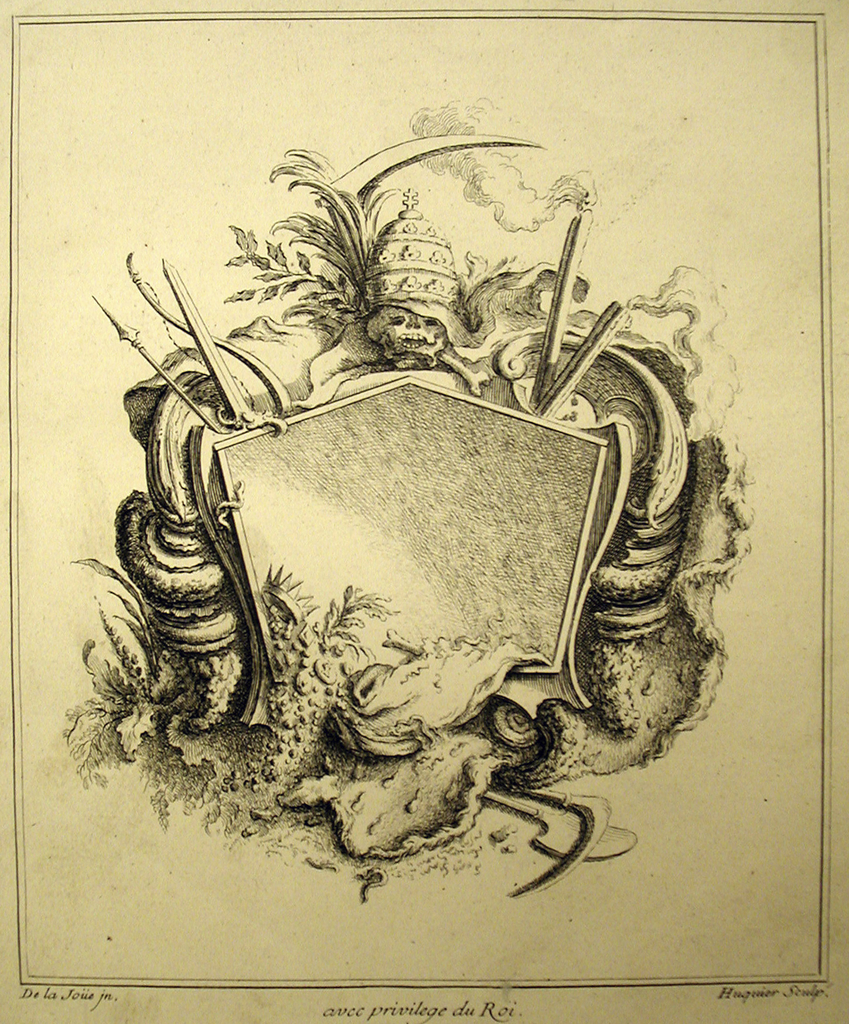This is a design for a cartouche by the French académician, ornemaniste, and painter Jacques de Lajoüe (1687- 1761). It was etched by Gabriel Huquier as plate 4 in his Second book of Cartouches (Deuxième livre de Cartouches), which was published in 1734 (as established by Roland Michel). The ascribed date locates this at a particularly prolific time in Lajoüe’s career as he began publishing his ornamental suites in 1734, while simultaneously executing his commissions for private patrons, such as the famous collector, Joseph Bonnier, Baron de la Mosson (1702-44).
The composition combines a symmetrical pentagonal cartouche with an elaborate collage of emblems and motifs. At the apex of the pentagon is a skull wearing the Triregnum, the three-crown papal tiara topped here with a patriarchal cross (also known as an archiepiscopal cross) instead of the usual globe and cross combination. Behind the skull are laurel leaves and a scythe. Surrounding them are expiring torches (emblems of death), a sword, a spear, a bow and grotesquely amplified fossilized and shell-like scrolls. At the lower edge of the cartouche are a crown, loose antique coins, reeds, foliage, a spade, and a pick. Together, the cartouche gives off a funerary undertone.
The very format of the cartouche comes from its etymological origins as a “forme cartel,” as a bordering element. Prints of fantastical cartouches became fashionable in the seventeenth-century through the efforts of Italian artists such as Agostino Mitelli and Stefano della Bella. In the eighteenth-century, artists such as Jacques Duvivier, Bernard Toro, Nicolas Pineau, François de Cuvilliés, Jacques Mondon, and Jacques de Lajoüe would continue the fashion for cartouche designs. These models were marketed to connoisseurs, amateurs, and young artists, but would sometimes be executed in woodwork and plaster as architectural ornaments. Throughout the eighteenth-century fantastical and imaginary cartouche designs served as a basis upon which artists and artisans could explore and expand upon the rococo style in vogue. If the rococo was criticized by critics such as Charles-Nicolas Cochin for ignoring the hierarchical distinction between the exterior and the interior, the cartouche served as a prime model for this transgression.
Lajoüe’s designs relished in asymmetry and formal mutability. They were sold with great demand in his lifetime and were owned by a class of connoisseurs including the comte de Toulouse, Madame de Pompadour, Duchess de Mazaran, as well as fellow artists such as Jean-Marc Nattier. Lajoüe has often been considered as one of the progenitors of the rococo style, as criticized by French architect Germain Boffrand as well as by the French académician and architect Jacques-François Blondel. This cartouche is a prime example of the paradigm of the rococo style where unconventional emblems culled from zoology, architecture, botany, sculpture, and even papal emblems were used in service of ornament.
Cabelle Ahn is a graduate intern in the Department of Drawings, Prints and Graphic Design at the Cooper Hewitt, Smithsonian Design Museum. She received her MA in Art History from the Courtauld Institute of Art and is currently studying eighteenth century decorative arts at the Bard Graduate Center.
